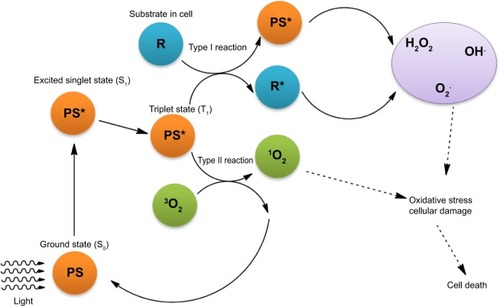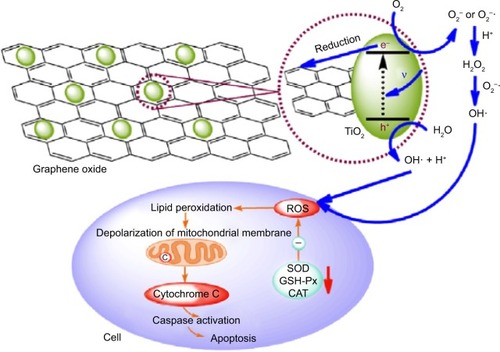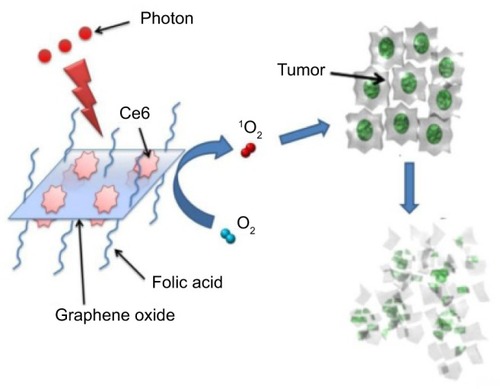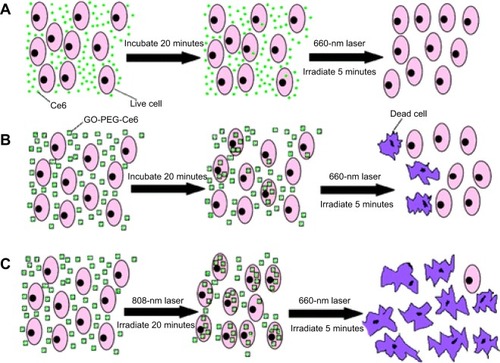Figures & data
Figure 1 Schematic representation of PS-initiated cell death.
Notes: When PS in cells is exposed to a specific wavelength of light, PS in its singlet ground state (S0) is transformed to its excited triplet state (T1) via a short-lived excited singlet state (S1) by intersystem crossing. The excited triplet can react directly either with substrate or solvent by transfer of hydrogen atom or electron to form radicals and radical ions upon interaction with oxygen. They can produce oxygenated products (H2O2, O2•−, and OH•) (Type I reaction) or can transfer their energy to oxygen directly to form singlet oxygen (1O2), which is a highly reactive, oxidative species (Type II reaction). Cellular damage is caused by these ROS, leading to tumor cell death. *Indicates activated state.
Abbreviations: PS, photosensitizer; ROS, reactive oxygen species.

Figure 2 Cell viability assay at different concentrations of NGO–mPEG/ZnPc on MCF-7 cells.
Notes: The graph represents results obtained under 10-minute light exposure with power intensity of 60 J/cm2 (light blue bars) and without light irradiation (dark blue bars). ***P<0.001, Student’s t-test.
Abbreviations: GO, graphene oxide; NGO–mPEG/ZnPc, methoxy-poly(ethylene glycol)-conjugated nano-GO loaded with zinc phthalocyanine.

Figure 3 The hypothetical mechanism of synergistic enhancement in GOT and its photodynamic effects on cancer cells.
Notes: Reprinted from Carbon, 50, Zhen Hu, Yudong Huang, Shaofan Sun, Wenchao Guan, Yuhuan Yao, Peiyi Tang, Cuiyun Li, Visible light driven photodynamic anticancer activity of graphene oxide/TiO2 hybrid, 994–1004, Copyright ©2012, with permission from Elsevier.Citation27
Abbreviations: CAT, catalase; GSH-Px, glutathione peroxidase; ROS, reactive oxygen species; SOD, superoxide dismutase; GOT, Graphene oxide/TiO2 hybrid.

Figure 4 Photosensitizer molecules of Ce6 loaded by folic acid–conjugated graphene oxide.
Note: Reproduced with permission from Ivyspring International Publisher. Huang P, Xu C, Lin J, et al. Folic acid-conjugated graphene oxide loaded with photosensitizers for targeting photodynamic therapy. Theranostics. 2011;1:240–250.Citation29
Abbreviation: Ce6, photosensitizer molecule Ce6.

Figure 5 Schemes of the experimental design in photothermally enhanced photodynamic therapy.
Notes: KB cells were incubated with (A) free Ce6; (B) GO–PEG–Ce6 for 20 minutes in the dark; and then irradiated with 660-nm laser (50 mW/cm2, 5 minutes, 15 J/cm2) in the control experiments, and (C) to induce the photothermal effect, cells incubated with GO–PEG–Ce6 were exposed to 808-nm laser (0.3 W/cm2, 20 minutes, 360 J/cm2) first before PDT treatment. Adapted with permission from Tian B, Wang C, Zhang S, Feng LZ, Liu Z. Photothermally enhanced photodynamic therapy delivered by nanographene oxide. ACS Nano. 2011;5:7000–7009. Copyright ©2011 American Chemical Society.Citation33
Abbreviations: GO, graphene oxide; GO–PEG–Ce6, polyethylene glycol–functionalized GO photosensitizer molecule Ce6; PDT, photodynamic therapy.

Figure 6 In vivo cancer therapy in HeLa tumor-bearing mice.
Notes: (A) Changes in the relative tumor volume (n=3) after different phototherapies. PDT only showed minimal effect on tumor growth, whereas PTT alone showed improved effect on tumor growth. The combination of PDT and PTT showed optimum therapeutic effect compared to PDT only (**P<0.001) or PTT only (*P<0.01). The dual therapy resulted in complete ablation of tumor tissue and no regrowth occurred within a span of 15 days. (B) Photographs of mice with tumors on the 15th day after treatment with saline, PDT only, PTT only, and PDT–PTT combined therapy. The mice with combined therapy showed no sign of tumor regrowth and the burned skin was also healed (the arrow indicates the healed site). P-values were calculated by the Student’s t-test: *P<0.01, **P<0.001. Reprinted from Biomaterials, 34, Sahu A, Choi WI, Lee JH, Tae G, Graphene oxide mediated delivery of methylene blue for combined photodynamic and photothermal therapy, 6239–6248, Copyright ©2013, with permission from Elsevier.Citation24
Abbreviations: PDT, photodynamic therapy; PTT, photothermal therapy.

Figure 7 Irradiation-activated apoptosis.
Notes: (A) Schematic illustration of the sequential irradiation-activated high-performance apoptosis. (B) In vitro cell ability of MDA-MB-231 cells treated with rGO–ZnO–HA following PDT, PTT, and combined PDT/PTT. The efficacy of combined treatment is compared with the additive efficacy of independent PDT and PTT treatments using t-tests with all P-values lower than 0.05. Reprinted from A multi-synergistic platform for sequential irradiation-activated high-performance apoptotic cancer therapy. Chen ZW, Li ZH, Wang JS, et al. Adv Funct Mater. 24:522–529. ©2013 WILEY-VCH Verlag GmbH & Co. KGaA, Weinheim.Citation34
Abbreviations: NIR, near infrared; PDT, photodynamic therapy; PTT, photothermal therapy; rGO–ZnO–HA, reduced graphene oxide–zinc oxide–hyaluronic acid complex; ROS, reactive oxygen species.

Figure 8 Schematic illustration of UCNP–NGO/ZnPc as a multifunctional theranostic nanoplatform for cancer treatment.
Notes: Reprinted from Biomaterials, 34, Wang YH, Wang HG, Liu DP, Song SY, Wang X, Zhang HJ. Graphene oxide covalently grafted upconversion nanoparticles for combined NIR mediated imaging and photothermal/photodynamic cancer therapy, 7715–7724, Copyright ©2013, with permission from Elsevier.Citation35
Abbreviations: GO, graphene oxide; PDT, photodynamic therapy; PTT, photothermal therapy; UCNP–NGO/ZnPc, upconversion nanoparticle–nano-GO–zinc phthalocyanine composite.

